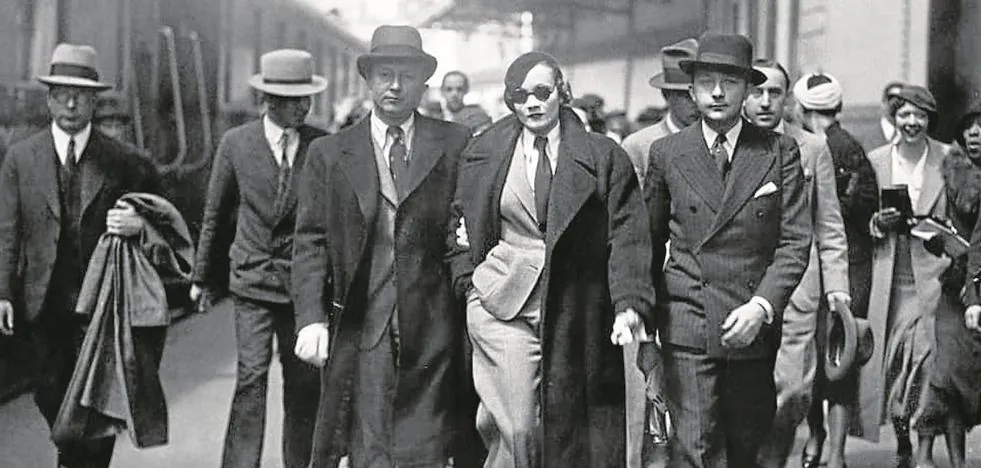There was a time, at the beginning of the 30s of the last century, when actors who were successful in the Spanish theater at the time, such as Pepe Isbert, Miguel Ligero, Antoñita Colomé, Rosita Díaz Jimeno, Carmen Moragas or Juanita Montenegro from Donostia, traveled to Paris to shoot movies at the branch that Paramount studios had set up 40 kilometers from the French capital, the first sound movies in Spanish. Directors such as Luis Buñuel or Florián Rey also attended. The experience lasted a short time, three years, and for this reason hardly any details are known. Now, Felipe Cabrerizo from San Sebastian and Santiago Aguilar from Madrid are joining forces again in a study on “that black hole”. The Film Academy has awarded them one of the Luis García Berlanga Film Research Grants.
The invention of sound cinema did not lead to the immediate application of dubbing. While the techniques are being developed, the big studios are beginning to take measures so as not to lose the non-English speaking public. Subtitles were not an alternative.
The first idea of the studios was to take the actors from Spain to Hollywood to shoot the Hispanic versions of the films in English. Paramount Pictures, looking for a much cheaper alternative, opened a small branch in the Parisian suburb of Joinville-le Pont to make its multilingual versions there.
Why exactly there? In that small town there were some old disused film studios that were renovated “to set up a system as if it were an assembly line,” says Cabrerizo. Another reason was its location. “Paris is in a strategic enclave that is easily accessible from London or Berlin, in addition to Madrid, in this case with its extension to Latin America where there was a huge potential market.”
seventeen languages
In this way, in the middle of 1930 the machinery of the studies starts up. The researchers summarize the frenetic activity that took place there: «A spirit of the cinematographic Tower of Babel welcomes the visitor. The production rhythm includes up to ten or twelve simultaneous versions. The procedure consists of designing sets and costumes in the image and likeness of the film to clone and reshoot the dialogue scenes of those made in Hollywood in Spanish, French, Swedish, Italian, German, Portuguese, Czech, Danish, Hungarian, Romanian, Serbo-Croatian, Polish, Norwegian, Russian… up to seventeen languages, with teams changing rapidly on set twenty-four hours a day. The Spanish team enters, they filmed for two hours and then they gave way to the same scene with the Germans. They even wear the same outfits. The films are shot in very short periods: twelve days on average». Stars from all countries coincided in the same study: «Pepe Isbert or Imperio Argentina were the same as Maurice Chevalier or Marlene Dietrich…».
Cabrerizo and Aguilar are focusing on what the Hispanic community did. «In Spain there was no sound film. That is why many of the Spanish talents traveled to Paris to see the mechanics of the studios. Some went for a small job, others settled there while the invention lasted». Two dozen films were shot in Spanish.
The tactic used by Hollywood in the Parisian studios was not to cover its most successful films. “For example, for the Fat and Skinny movies it was impossible to find two actors to replace them. In that case they tried to teach them languages and when they spoke so strangely it was because they doubled themselves. Nor can you replace a figure like Greta Garbo, “explains Cabrerizo. The alternative was to recover films that had not been successful or that were in the background.
The movie that worked best was the musical ‘Melodía de arrabal’, with Carlos Gardel and Imperio Argentina. “The Argentine was a very important character. The idea was to bring together the great idol of Latin America with the most famous Spanish actress. Regarding other films that were made, the economic returns are being difficult to follow because “they were shot and circulated a lot in places where Spanish was present, even in the Philippines.” In addition, the transition from Latin American cinemas to sound cinemas was much slower than in Spain and projections lasted a long time.
What happened to all those movies? Cabrerizo refers to a legend: «When Paramount concluded his work in Joinville, he decided to take the cans with all the tapes produced there to Hollywood. Apparently, the freighter sank crossing the Atlantic, which ended almost any trace of a production that laid the technical foundations of sound films in Spain and Latin America».

